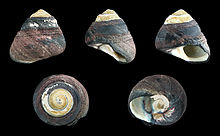Tegula funebralis
| Tegula funebralis | |
|---|---|
 |
|
| A Tegula funebralis in Santa Cruz, California | |
 |
|
| Five views of a shell of Tegula funebralis | |
| Scientific classification | |
| Kingdom: | Animalia |
| Phylum: | Mollusca |
| Class: | Gastropoda |
| Clade: | Vetigastropoda |
| Superfamily: | Trochoidea |
| Family: | Tegulidae |
| Genus: | Tegula (gastropod) |
| Species: | T. funebralis |
| Binomial name | |
|
Tegula funebralis (A. Adams, 1855) |
|
| Synonyms | |
|
|
The black turban snail or black tegula, scientific name Tegula funebralis, is a species of medium-sized marine sea snail in the family Tegulidae. This Eastern Pacific Ocean species was previously known as Chlorostoma funebralis.
Most adults have shells which are 20 to 50 mm (or about an inch, to an inch and three quarters) in diameter. Adults weigh anywhere from 2 to 20 grams . Individuals can live anywhere from 7 to 30 years; studies have shown that individuals inhabiting the more northern portions of the organism's range are larger and live longer on average than organisms inhabiting the southern portions.
In 1971, a new sense organ was discovered in this marine snail. Chemoreceptor organs were found near the base on the border of the leaflets of the ctenidium (comb-like respiratory gills), one on each leaflet. They form a light swelling near the base of the leaflet with a pocket lying within the swelling. Together they are termed a "bursicle".
Black turban snails are found along the Pacific coast of North America from British Columbia to Baja California, where they are one of the most abundant snail species. Studies have recorded black turban snail densities of up to 1,400 individuals per m2 near Monterey, California. Local densities of black turban snails are influenced by many factors, including abundance of food, predators, and suitable habitat.
Black turban snails inhabit rocky intertidal zones, between low and high tide lines. Juveniles are found mostly under rocks and among coarse sands. Empty black turban snail shells are often utilized by another common intertidal animal, the hermit crab.
...
Wikipedia
